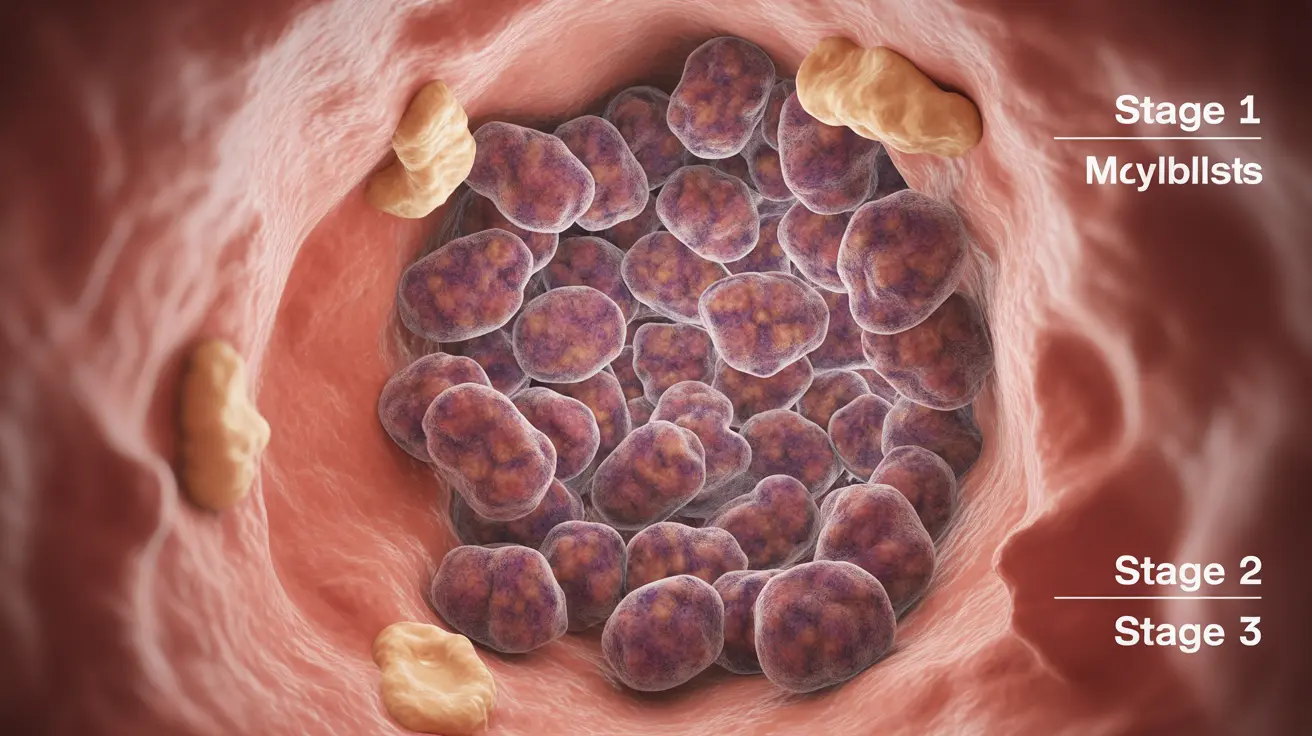Myeloblasts are crucial components of our blood system, serving as immature cells that eventually develop into specific types of white blood cells essential for immune function. These precursor cells play a vital role in maintaining healthy blood composition and defending against infections. Understanding myeloblasts is particularly important because abnormalities in their development or quantity can signal serious blood disorders.
In this comprehensive guide, we'll explore what myeloblasts are, their normal function in the body, and what it means when their levels become abnormal. We'll also discuss related blood disorders, diagnostic procedures, and treatment approaches for conditions involving myeloblasts.
What Are Myeloblasts and Their Normal Function?
Myeloblasts are immature blood cells found in bone marrow that develop through a process called myelopoiesis. These cells are the earliest recognizable precursors of granulocytes, which include neutrophils, basophils, and eosinophils. In healthy individuals, myeloblasts make up a small percentage of bone marrow cells and rarely appear in peripheral blood.
The normal maturation process of myeloblasts involves several stages, during which these cells gradually develop into fully functional white blood cells. This process is carefully regulated by various growth factors and genetic signals to maintain proper blood cell production.
Abnormal Myeloblast Levels and Disease Association
When myeloblast levels become abnormal, it often indicates a serious blood disorder. The most significant condition associated with elevated myeloblast counts is Acute Myeloid Leukemia (AML), where immature myeloblasts accumulate in the bone marrow and blood, interfering with normal blood cell production.
Common Conditions Related to Abnormal Myeloblasts
Several blood disorders can affect myeloblast levels and function:
- Acute Myeloid Leukemia (AML)
- Myelodysplastic Syndromes (MDS)
- Chronic Myeloid Leukemia (CML)
- Myeloproliferative Disorders
Signs and Symptoms of Myeloblast Disorders
When myeloblast-related disorders develop, patients may experience various symptoms:
- Frequent infections
- Unusual bleeding or bruising
- Persistent fatigue
- Shortness of breath
- Pale skin
- Bone pain
- Unexplained weight loss
- Night sweats
Diagnostic Procedures and Testing
Diagnosing myeloblast disorders involves several specialized tests:
Complete Blood Count (CBC)
This initial test measures various blood cell components and can identify abnormalities in blood cell counts.
Bone Marrow Biopsy
This procedure involves collecting bone marrow samples to examine the number and appearance of myeloblasts and other blood cells.
Flow Cytometry
This advanced test helps identify specific cellular markers on myeloblasts, aiding in precise diagnosis and classification of blood disorders.
Treatment Approaches
Treatment for myeloblast-related disorders varies depending on the specific condition, its severity, and the patient's overall health. Common treatment options include:
- Chemotherapy
- Targeted therapy
- Stem cell transplantation
- Supportive care measures
- Clinical trials for new treatments
Frequently Asked Questions
What is a myeloblast and what role does it play in the body's immune system?
A myeloblast is an immature blood cell that develops into specific types of white blood cells in the bone marrow. These cells are essential for immune system function as they mature into granulocytes that help fight infections and maintain immune defense.
What does a high myeloblast count indicate and how is it related to acute myeloid leukemia (AML)?
An elevated myeloblast count often indicates the presence of acute myeloid leukemia (AML). In AML, immature myeloblasts accumulate in the bone marrow and blood, disrupting normal blood cell production. A diagnosis of AML typically requires more than 20% myeloblasts in the bone marrow or blood.
What symptoms might suggest a problem with myeloblasts or related blood disorders?
Common symptoms include frequent infections, easy bruising or bleeding, persistent fatigue, shortness of breath, bone pain, and unexplained weight loss. These symptoms occur because abnormal myeloblasts interfere with normal blood cell production and function.
How are myeloblast levels tested and diagnosed in medical practice?
Myeloblast levels are primarily tested through blood tests and bone marrow biopsies. Doctors use complete blood counts, microscopic examination of blood smears, flow cytometry, and genetic testing to assess myeloblast numbers and characteristics.
What are the treatment options and prognosis for someone diagnosed with a blood disorder involving abnormal myeloblasts?
Treatment options typically include chemotherapy, targeted therapy, and stem cell transplantation. The prognosis varies significantly depending on the specific condition, age, overall health, and genetic factors. Early diagnosis and treatment often lead to better outcomes.




